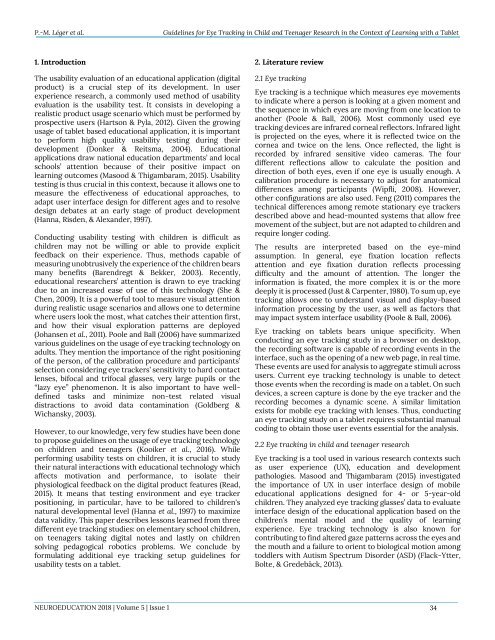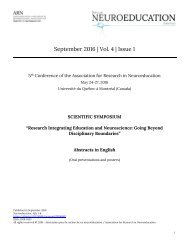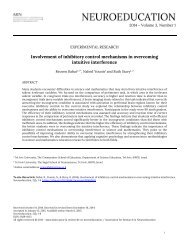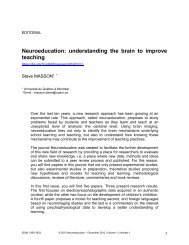Neuroeducation_2018_vol-5_no-1_full
Volume 5, Numéro 1 de la revue scientifique bilingue en libre accès Neuroéducation
Volume 5, Numéro 1 de la revue scientifique bilingue en libre accès Neuroéducation
- No tags were found...
You also want an ePaper? Increase the reach of your titles
YUMPU automatically turns print PDFs into web optimized ePapers that Google loves.
P.-M. Léger et al.<br />
Guidelines for Eye Tracking in Child and Teenager Research in the Context of Learning with a Tablet<br />
1. Introduction<br />
2. Literature review<br />
The usability evaluation of an educational application (digital<br />
product) is a crucial step of its development. In user<br />
experience research, a commonly used method of usability<br />
evaluation is the usability test. It consists in developing a<br />
realistic product usage scenario which must be performed by<br />
prospective users (Hartson & Pyla, 2012). Given the growing<br />
usage of tablet based educational application, it is important<br />
to perform high quality usability testing during their<br />
development (Donker & Reitsma, 2004). Educational<br />
applications draw national education departments’ and local<br />
schools’ attention because of their positive impact on<br />
learning outcomes (Masood & Thigambaram, 2015). Usability<br />
testing is thus crucial in this context, because it allows one to<br />
measure the effectiveness of educational approaches, to<br />
adapt user interface design for different ages and to resolve<br />
design debates at an early stage of product development<br />
(Hanna, Risden, & Alexander, 1997).<br />
Conducting usability testing with children is difficult as<br />
children may <strong>no</strong>t be willing or able to provide explicit<br />
feedback on their experience. Thus, methods capable of<br />
measuring u<strong>no</strong>btrusively the experience of the children bears<br />
many benefits (Barendregt & Bekker, 2003). Recently,<br />
educational researchers’ attention is drawn to eye tracking<br />
due to an increased ease of use of this tech<strong>no</strong>logy (She &<br />
Chen, 2009). It is a powerful tool to measure visual attention<br />
during realistic usage scenarios and allows one to determine<br />
where users look the most, what catches their attention first,<br />
and how their visual exploration patterns are deployed<br />
(Johansen et al., 2011). Poole and Ball (2006) have summarized<br />
various guidelines on the usage of eye tracking tech<strong>no</strong>logy on<br />
adults. They mention the importance of the right positioning<br />
of the person, of the calibration procedure and participants’<br />
selection considering eye trackers’ sensitivity to hard contact<br />
lenses, bifocal and trifocal glasses, very large pupils or the<br />
“lazy eye” phe<strong>no</strong>me<strong>no</strong>n. It is also important to have welldefined<br />
tasks and minimize <strong>no</strong>n-test related visual<br />
distractions to avoid data contamination (Goldberg &<br />
Wichansky, 2003).<br />
However, to our k<strong>no</strong>wledge, very few studies have been done<br />
to propose guidelines on the usage of eye tracking tech<strong>no</strong>logy<br />
on children and teenagers (Kooiker et al., 2016). While<br />
performing usability tests on children, it is crucial to study<br />
their natural interactions with educational tech<strong>no</strong>logy which<br />
affects motivation and performance, to isolate their<br />
physiological feedback on the digital product features (Read,<br />
2015). It means that testing environment and eye tracker<br />
positioning, in particular, have to be tailored to children's<br />
natural developmental level (Hanna et al., 1997) to maximize<br />
data validity. This paper describes lessons learned from three<br />
different eye tracking studies: on elementary school children,<br />
on teenagers taking digital <strong>no</strong>tes and lastly on children<br />
solving pedagogical robotics problems. We conclude by<br />
formulating additional eye tracking setup guidelines for<br />
usability tests on a tablet.<br />
2.1 Eye tracking<br />
Eye tracking is a technique which measures eye movements<br />
to indicate where a person is looking at a given moment and<br />
the sequence in which eyes are moving from one location to<br />
a<strong>no</strong>ther (Poole & Ball, 2006). Most commonly used eye<br />
tracking devices are infrared corneal reflectors. Infrared light<br />
is projected on the eyes, where it is reflected twice on the<br />
cornea and twice on the lens. Once reflected, the light is<br />
recorded by infrared sensitive video cameras. The four<br />
different reflections allow to calculate the position and<br />
direction of both eyes, even if one eye is usually e<strong>no</strong>ugh. A<br />
calibration procedure is necessary to adjust for anatomical<br />
differences among participants (Wipfli, 2008). However,<br />
other configurations are also used. Feng (2011) compares the<br />
technical differences among remote stationary eye trackers<br />
described above and head-mounted systems that allow free<br />
movement of the subject, but are <strong>no</strong>t adapted to children and<br />
require longer coding.<br />
The results are interpreted based on the eye-mind<br />
assumption. In general, eye fixation location reflects<br />
attention and eye fixation duration reflects processing<br />
difficulty and the amount of attention. The longer the<br />
information is fixated, the more complex it is or the more<br />
deeply it is processed (Just & Carpenter, 1980). To sum up, eye<br />
tracking allows one to understand visual and display-based<br />
information processing by the user, as well as factors that<br />
may impact system interface usability (Poole & Ball, 2006).<br />
Eye tracking on tablets bears unique specificity. When<br />
conducting an eye tracking study in a browser on desktop,<br />
the recording software is capable of recording events in the<br />
interface, such as the opening of a new web page, in real time.<br />
These events are used for analysis to aggregate stimuli across<br />
users. Current eye tracking tech<strong>no</strong>logy is unable to detect<br />
those events when the recording is made on a tablet. On such<br />
devices, a screen capture is done by the eye tracker and the<br />
recording becomes a dynamic scene. A similar limitation<br />
exists for mobile eye tracking with lenses. Thus, conducting<br />
an eye tracking study on a tablet requires substantial manual<br />
coding to obtain those user events essential for the analysis.<br />
2.2 Eye tracking in child and teenager research<br />
Eye tracking is a tool used in various research contexts such<br />
as user experience (UX), education and development<br />
pathologies. Masood and Thigambaram (2015) investigated<br />
the importance of UX in user interface design of mobile<br />
educational applications designed for 4- or 5-year-old<br />
children. They analyzed eye tracking glasses’ data to evaluate<br />
interface design of the educational application based on the<br />
children’s mental model and the quality of learning<br />
experience. Eye tracking tech<strong>no</strong>logy is also k<strong>no</strong>wn for<br />
contributing to find altered gaze patterns across the eyes and<br />
the mouth and a failure to orient to biological motion among<br />
toddlers with Autism Spectrum Disorder (ASD) (Flack-Ytter,<br />
Bolte, & Gredebäck, 2013).<br />
NEUROEDUCATION <strong>2018</strong> | Volume 5 | Issue 1 34








